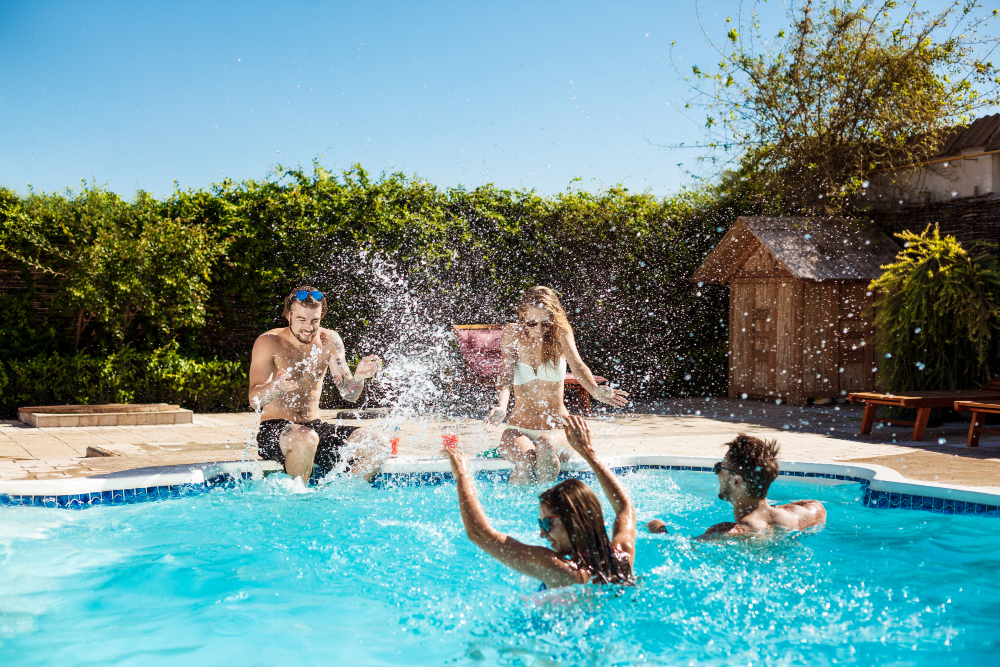Shocking a pool is a vital part of its maintenance routine. It involves adding a concentrated dose of chlorine or other chemicals to the pool water in order to quickly eliminate contaminants and restore water clarity. However, it is important to wait for the appropriate amount of time before diving back in for a refreshing swim after shocking a pool. In this article, we will discuss how long after you shock a pool can you swim.
Understanding Pool Shock
Pool shock, also known as superchlorination, is the process of adding high levels of chlorine to a pool to destroy organic contaminants such as bacteria, algae, and other impurities. This helps to maintain water quality and ensure a safe swimming environment. Without regular shocking, a pool can become a breeding ground for harmful pathogens and unsightly algae.
:max_bytes(150000):strip_icc()/pool-GettyImages-746026237-2000-fdf1bcebc5e842758ed21f8e8f6d7054.jpg)
Credit: www.health.com
The Importance of Waiting
While shocking a pool is necessary for maintaining a clean and clear swimming environment, it is essential to exercise caution and allow the shock treatment to fully work its magic before re-entering the pool.
The recommended waiting period after shocking a pool can vary depending on the type and brand of pool shock used, as well as the specific mixing instructions provided. However, as a general guideline, it is best to wait at least 24 to 48 hours before swimming in a pool that has been shocked.
During this waiting period, the shock treatment will effectively sanitize and balance the pool water. It will neutralize any excess chlorine present, making the water safe and comfortable for swimmers. Swimming too soon after shocking a pool can result in skin and eye irritation due to high chlorine levels, which can cause discomfort and spoil the swimming experience.
Tips for Faster Pool Recovery
While the waiting period after shocking a pool is necessary for optimal results, there are a few steps you can take to speed up the recovery process and minimize the downtime:
- Follow the manufacturer’s instructions: Different pool shock products have different recommended waiting times. Be sure to carefully read and follow the instructions provided on the shock treatment packaging.
- Test the pool water: Use a reliable pool water testing kit to check the chlorine levels. Only consider swimming if the chlorine levels have dropped to a safe range. Ideal chlorine levels for swimming pools typically fall between 1.0 and 3.0 parts per million (ppm).
- Ensure proper filtration and circulation: Run your pool pump and filter system for a longer duration during the waiting period. This will help to expedite the removal of excess chemicals and enhance water circulation, promoting faster recovery.
- Monitor water clarity: Wait for the pool water to regain its clarity and become visibly clean before using the pool. This is a good indicator that the shock treatment has effectively eliminated the contaminants.

Credit: www.inyopools.com
Frequently Asked Questions
Q: What is pool shocking?
A: Pool shocking involves adding a large dose of chlorine or other chemicals to the pool to quickly raise the chlorine level, eliminating bacteria, algae, and other contaminants. It helps maintain clear and sanitary water.
Q: How long should I wait to swim after shocking the pool?
A: Wait at least 24 hours after shocking your pool before swimming. This allows the chlorine level to return to a safe range. Always test the water to ensure chlorine levels are between 1-3 ppm before entering.
Q: Why is it important to wait before swimming after shocking the pool?
A: Swimming too soon after shock can cause skin and eye irritation, respiratory issues, and other health problems due to the high chlorine levels. Ensuring the chlorine level has dropped to a safe range protects swimmers’ health.
Q: How can I test if the pool is safe to swim in after shock?
A: Use a pool testing kit or test strips to measure the chlorine levels. The water is safe for swimming when free chlorine levels are between 1-3 ppm and combined chlorine is below 0.5 ppm. Always confirm these readings before swimming.
Q: Can I speed up the process of chlorine reduction after shocking?
A: Yes, running the pool pump and filter continuously can help disperse the chlorine more evenly and reduce levels faster. Additionally, exposing the pool to sunlight helps chlorine dissipate more quickly.
Q: Are there different types of pool shock products, and do they affect the waiting time?
A: Yes, there are various pool shock products such as calcium hypochlorite, sodium dichlor, and non-chlorine shock. The recommended waiting time can vary, so always follow the manufacturer’s instructions on the product label.
Q: What should I do if the chlorine level remains high after 24 hours?
A: If the chlorine level is still high after 24 hours, continue running the pump and filter. Retest the water periodically until the levels are safe. Avoid adding more chlorine or chemicals until the levels decrease to the recommended range.
Q: Is it safe to shock my pool during the day?
A: It’s better to shock your pool in the evening or at night. Sunlight can break down chlorine quickly, reducing the effectiveness of the shock treatment. Shocking at night allows the chlorine to work without interference from UV rays.
Final Words
Shocking a pool is an essential step in its maintenance routine that helps to keep the water clean, clear, and safe for swimming. However, it is crucial to wait for the appropriate amount of time after shocking a pool before jumping back in.
Waiting for at least 24 to 48 hours allows the shock treatment to work effectively and ensures that the chlorine levels in the pool have balanced out, preventing skin and eye irritation. Remember to follow the recommendations provided by the manufacturer, test the chlorine levels, and monitor water clarity to speed up the recovery process.
By following these guidelines, you can maintain a healthy and enjoyable swimming environment while ensuring the safety and comfort of all swimmers. Happy swimming!




